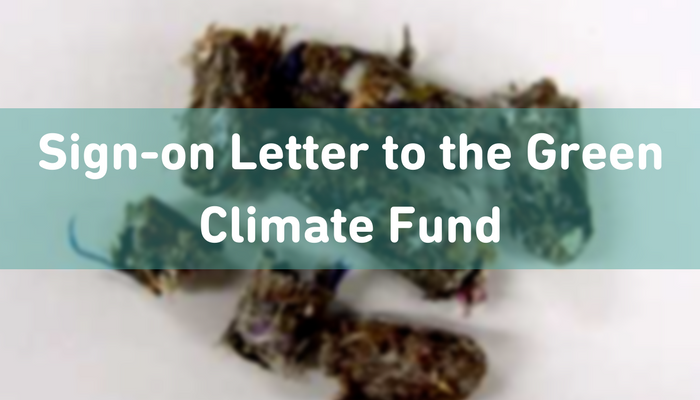Sign-on Letter to the Green Climate Fund

THIS SIGN ON IS NOW CLOSED
 Dear Members and Alternate Members of the Board of the Green Climate Fund:
Dear Members and Alternate Members of the Board of the Green Climate Fund:
We are writing to express our support for ambitious climate action in the waste management sector and urge you to prioritise resource-efficiency, sustainability and development of local economies, rather than projects aiming at using waste as a source of energy, such production of Refuse-Derived Fuels for waste-to-energy incineration or production of cement.
Our alarm has been triggered by the project “Sustainable Energy Financing Facilities”, funded by the European Bank for Reconstruction and Development and the Green Climate Fund. The project proposal, available at the Green Climate Fund website, includes as an example of renewable energy technology: “Advanced waste management with production of RDF (refused derived fuels)”, side by side to solar panels and wind turbines.
The production of Refuse-Derived Fuels is not a renewable energy project that deserves funding from the Green Climate Fund – it is a false solution that is preventing the application of the Waste Hierarchy and appropriate waste management system aimed at preventing waste and expanding reuse, recycling, and composting programs — that is, aiming for zero waste.
Refuse Derived Fuel is made of mixed municipal solid waste, typically composed of approximately one third plastics (made of fossils fuels), another third of biomass materials such as paper, textiles or wood (which could have been recycled or reused), and one third unknown materials1. Refuse Derived Fuel is often used as fuel in the production of cement, or other combustion plants.
The use of RDF in cement plants or other industries cannot be considered a renewable energy project or one that fosters climate ambition for the following reasons:
- The use of materials that could have been recycled or reused as fuel, represents a subversion of the Waste Hierarchy.
- The use of plastics as fuels cannot in any circumstance be considered renewable energy, given they’re made of fossil fuels.
- Waste-to-energy incineration increases GHG and toxic emissions with most severe impacts to the public health and environment of vulnerable communities in clear exacerbation of climate injustice.
Moreover, RDF is often used as fuel for cement production, even though cement plants do not have the means to filter volatile heavy metals (mercury, thallium, cadmium, etc.) that are present in waste, neither they can filter the toxic emissions with persistent organic pollutants (POPs) such as dioxins and furans (PCDD/PCDF), which are banned under the Stockholm Convention. POPS pose a global threat to human health and the environment due to their specific characteristics. They are toxic and persistent in the environment, can travel long distances and accumulate in the food chain.
In contrast, preventing waste and expanding reuse, recycling, and composting programs — that is, aiming for zero waste — is one of the fastest, cheapest, and most effective strategies available for combating climate change.
A zero waste approach — based on waste prevention, reuse, recycling, composting, and anaerobic digestion — reduces greenhouse gas emissions in all of the following ways:
- Reducing energy consumption associated with manufacturing, transporting, and using the product or material;
- Reducing non-energy-related manufacturing emissions, such as the CO2 released when limestone is converted to the lime that is needed for aluminium and steel production;
- Reducing methane emissions from landfills;
- Reducing CO2 and nitrous oxide (N2O) emissions from incinerators;
- Reducing pressure on virgin materials from forests and therefore increasing its carbon uptake, which absorb CO2 from the atmosphere and store it as carbon for long periods (thus rendering the carbon unavailable to contribute to greenhouse gases);
- Increasing carbon storage in products and materials; and increasing carbon storage in soils by restoring depleted stocks of organic matter
In conclusion, we urge you to develop a sustainability criteria for the projects to be approved in relation to the waste management sector, and ensure the principles of the Waste Hierarchy and Zero Waste are given priority.
We enclose our latest policy briefing Climate Finance for the Waste Management Sector – Guidance for Policy-Makers and Project Developers, to ensure you have enough tools and examples to guide your decision-making process.
Thanks you very much in advance for your consideration of these matters.
Sincerely,
Zero Waste Europe
Aire Valley Against Incineration
Kentucky Environmental Foundation
European Environmental Bureau
Friends of the Earth Europe
Environmental Assocation Za Zemiata
Friends of the Earth Croatia
Zero Waste France
Institute for Policy Studies
Zero Waste Montenegro
Zero Zabor ibe Basque Country
Ethiopian Society for Consumer Protection
Institute for Local Self-Reliance
Californian Communities Against Toxics
Work on Waste, USA
American Environmental Health Studies Project
Don’t Waste Arizona
GAIA
CLEAN (Coastal Livelihood and Environmental Action Network)
National Toxics Networks Austrailia
Asian People’s Movement on Debt and Development
Friends of the Earth U.S
Mother Earth Foundation Philippines
Center for Participatory Research and Development (CPRD)
Friends of the Earth Malaysia
Consumer’s Association of Penang
Returning Organics to Soil
Calerdale Green Party
Let’s Do It Foundation
Sound Resource Management Group, Inc.
VšĮ “Žiedinė ekonomika” (Zero Waste Lithuania)
Ekologi brez meja (Ecologists without Borders)
- Currie, J. (2011), The valorisation of SRF in cement kilns, Workshop and sitevisit: Production and utilisation options for Solid Recovered Fuels, IEA Bioenergy Task 32 and 36, Dublin, 20-21 October 2011.
THIS SIGN ON IS NOW CLOSED